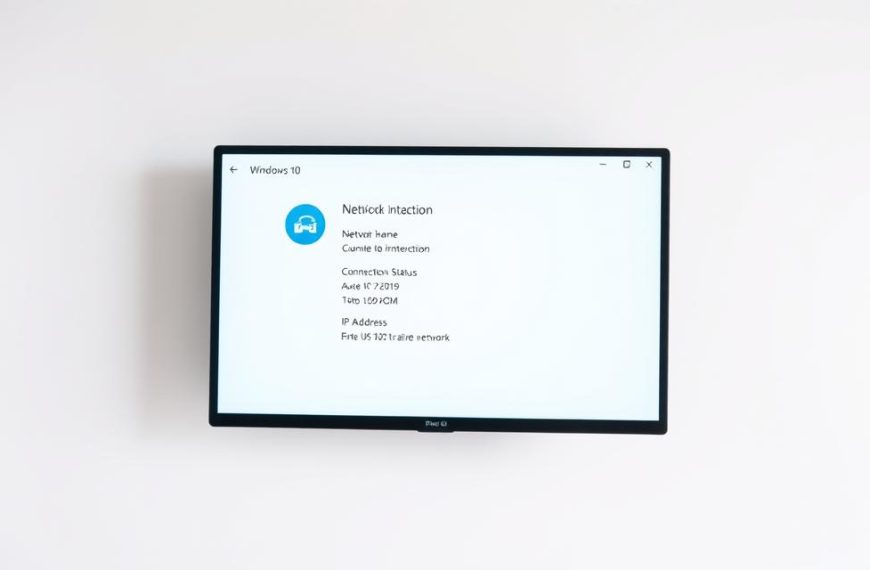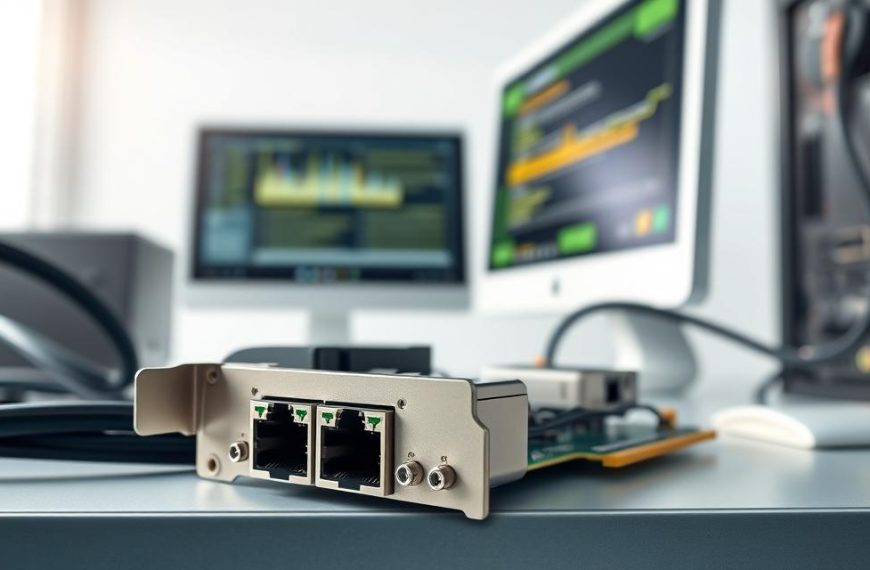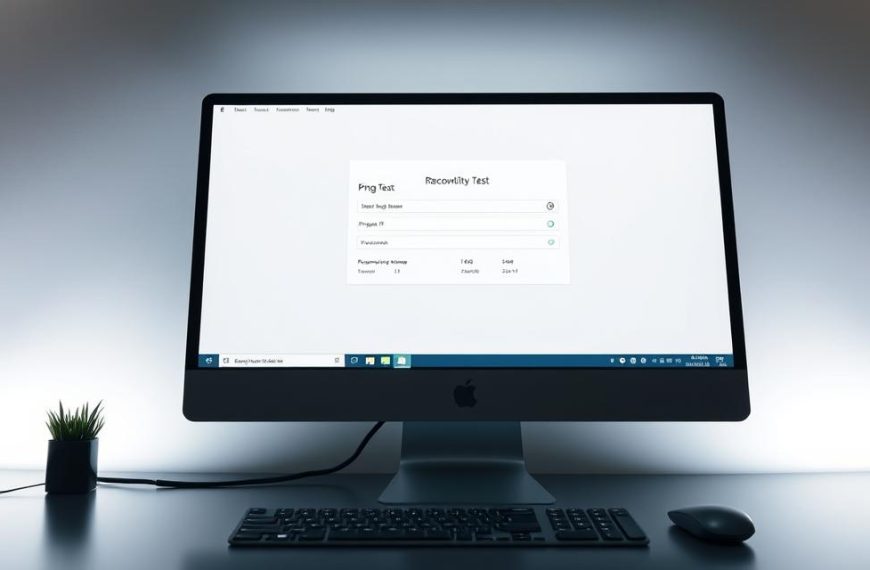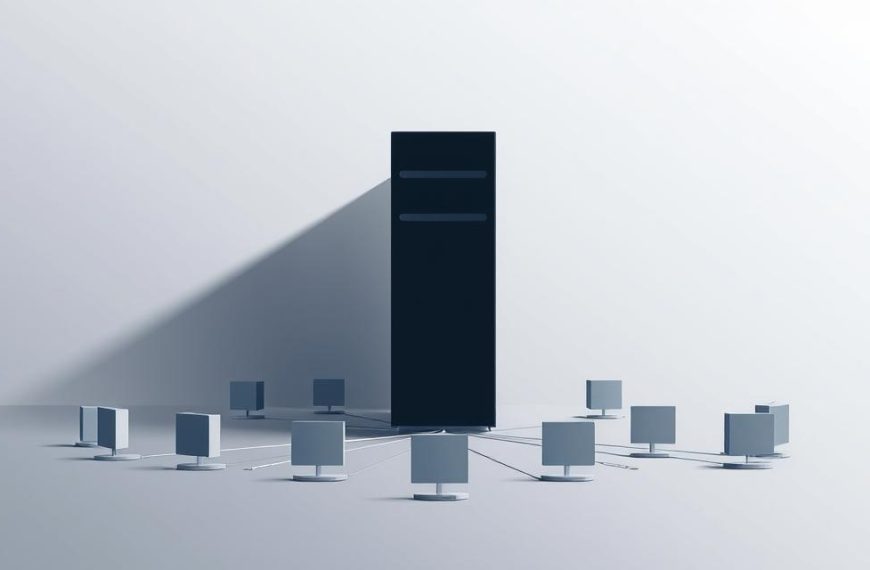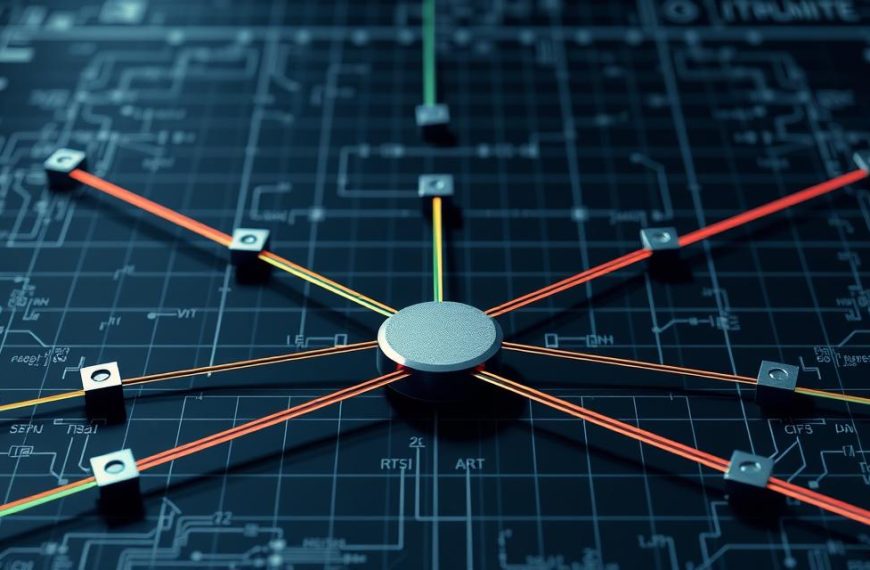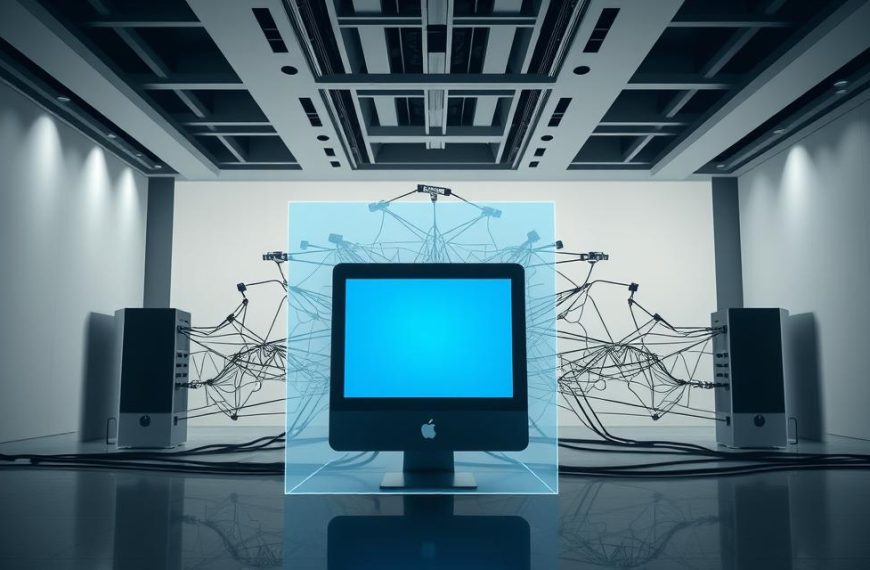Today, many companies use connected systems to boost productivity and teamwork. These systems are great, but they also bring big risks that need to be handled with care.
Networks face many security challenges that can harm important data. Issues like unauthorised access and cyber threats worry IT teams all over the world.
Businesses also struggle with managing networked systems. Keeping all devices running smoothly needs special skills and constant effort.
The disadvantages of networking are real and can slow down operations. Knowing these risks helps companies build stronger digital plans.
This article looks into the computer network risks that businesses face today. We’ll see how these problems affect work and what can be done to fix them.
Understanding the Downsides of Networked Systems
Computer networks bring many benefits but also face significant challenges. The complex nature of today’s digital world creates many vulnerabilities. These can affect the whole system if problems occur.
Research shows 43% of small businesses face cyber attacks. This highlights the risks of being connected. It shows that being online can make you more vulnerable to threats.
Key Areas of Concern
There are several key areas to focus on when looking at network drawbacks. These areas are important for understanding why we need to plan and manage networks carefully.
One major issue is the spread of viruses and malware. Studies show that connected devices have a 70% chance of spreading viruses once one device is infected. This shows how small problems can quickly become big issues for the whole organisation.
Network dependencies add to the complexity. When systems are connected, problems in one area can affect the whole network. This means small issues can turn into big problems.
Managing distributed systems is also a big challenge. It requires special knowledge and constant monitoring. Many organisations don’t realise these issues until after they start using the network.
Networked systems also come with operational risks. These include concerns about data integrity and service availability. Understanding these risks is key to developing good strategies and plans.
“The complexity of modern networked systems introduces vulnerabilities that extend far beyond traditional security concerns.”
These concerns show why careful planning and strong security are vital for networks. The next sections will look at these disadvantages in more detail. They will offer practical advice for organisations facing these challenges.
What are the Disadvantages of a Computer Network: Security Vulnerabilities
Networks have many entry points for cyber threats. These threats can harm entire organisations. Security weaknesses in one part can spread to the whole system.
Common Security Risks
Modern networks face many threats that need careful protection. Knowing these dangers helps in making strong malware protection and security plans.
Malware Infections
Malicious software spreads fast in networks. Viruses, ransomware, and trojans can spread 10-100 times faster than on single machines.
This fast spread happens because networks have many paths for infection. One infected device can harm dozens of others quickly.
Unauthorised Access
Hackers can easily get past weak security and steal data. Poor passwords, unpatched software, and wrong firewall settings are common entry points.
To stop unauthorised access, use many security layers. This includes regular checks, training, and strong authentication.
Impact of Security Breaches
When security fails, the problems are big. The data breach impact can last for years.
Financial losses are just one issue. A data breach can cost about £3 million. This includes recovery costs and lost sales.
Reputational damage is also a big problem. It can scare off customers and partners. Disruptions during recovery make things worse.
| Security Risk Type | Transmission Speed | Primary Targets | Prevention Methods |
|---|---|---|---|
| Ransomware Attacks | Extremely Fast (minutes) | Critical business data | Regular backups, employee training |
| Phishing Schemes | Rapid (hours-days) | User credentials | Email filtering, security awareness |
| DDoS Attacks | Immediate | Network availability | Traffic monitoring, redundancy plans |
| Data Exfiltration | Stealthy (weeks-months) | Sensitive information | Encryption, access controls |
Cyber attacks hit 43% of small businesses. This shows networks are vulnerable, even with security steps. Many don’t know they’re at risk until it’s too late.
Legal issues after a breach can be costly. Fines and lawsuits are common. Laws keep changing to deal with network security risks.
Network Management Complexities
Network management complexities are often overlooked in computer networking. These challenges arise after setup, causing ongoing issues that need expert care and constant focus.
Administrative Overhead
Managing computer networks is a big task that needs a lot of resources. Companies must hire skilled IT staff. They need to know a lot about network protocols, security, and fixing problems.
Keeping an eye on the network is key. IT teams must always be ready to spot performance issues, security threats, and other problems. They need special tools and must be on duty all the time.
Managing user accounts is also complex. Admins have to handle permissions, access controls, and authentication. They also need to follow company policies.
Configuration Issues
Setting up network configurations is a big technical challenge. It involves setting up routing tables, protocol settings, and security parameters. It needs careful work and testing.
Wrong configurations can cause big problems. They can lead to security issues or slow down the network. This can happen if access controls or firewalls are not set right.
Keeping all devices in sync is hard. Each router, switch, and server needs its own care. But they must all work together smoothly.
| Management Challenge | Technical Complexity | Potential Impact | Required Expertise |
|---|---|---|---|
| Network Monitoring | High | Performance optimisation | Network analysis specialists |
| Security Configuration | Very High | Vulnerability prevention | Security engineers |
| User Access Management | Medium | Data protection | System administrators |
| Protocol Configuration | High | Network stability | Network architects |
These IT management complexities show why companies need to invest in network management. They need skilled people and the right tools to handle these challenges.
High Implementation and Maintenance Costs
Setting up a computer network costs more than just the initial price. It leads to long-term financial commitments that many overlook. These costs are a big disadvantage that needs careful planning and budgeting.
Building a network is 20-30% more expensive than using standalone machines. This big difference in network implementation costs makes financial analysis key for any organisation thinking about it.
Initial Setup Expenses
Starting a network means big investments. You need to buy servers, routers, switches, and lots of cables.
Software costs a lot too. You’ll need to pay for network operating systems, security software, and application licenses. Professional installation and setup help are also needed.
These costs make the start-up IT infrastructure investment much higher than for standalone systems. Good planning can help avoid some unexpected costs.
Ongoing Maintenance Costs
After setting up, the costs keep coming. You’ll need to pay for software updates and might need consultant help. As technology changes, you’ll need to upgrade your hardware.
Keeping your network safe is also a big ongoing cost. You’ll need IT staff, which standalone systems don’t. Plus, the energy your network uses adds to your costs.
These maintenance expenses can increase your support costs by 15-25% compared to non-networked systems. Remember, the total cost of ownership is important. Many organisations focus on the start-up costs but forget about the ongoing ones.
| Cost Category | Networked Systems | Standalone Systems | Cost Difference |
|---|---|---|---|
| Initial Implementation | £15,000-£25,000 | £10,000-£18,000 | 20-30% higher |
| Annual Maintenance | £3,000-£5,000 | £1,500-£3,000 | 15-25% higher |
| Software Updates | £1,200-£2,000/year | £600-£1,200/year | Approximately 50% higher |
| Energy Consumption | £800-£1,500/year | £400-£800/year | 40-50% higher |
| 5-Year Total Cost | £28,000-£45,000 | £18,000-£30,000 | 25-35% higher |
This comparison shows how the total cost of ownership for networks often goes over initial estimates. Organisations must think about both start-up and ongoing costs when deciding on networking.
Performance and Reliability Issues
Computer networks face big challenges in keeping performance steady and reliable. These problems can really hurt productivity and business operations. It’s a big worry for any organisation.
Network reliability issues can cause big problems. A study found that network downtime costs businesses about £4,400 per minute. This shows how much these technical issues can cost.
Network Congestion
Network congestion happens when too many devices try to talk at once. This can make the network slow down. Up to 80% of networks get congested during busy times.
What happens when networks get congested?
- Data transfer speeds slow down, affecting file sharing and backups.
- Applications take longer to respond, which is bad for business software.
- Latency increases, making video conferencing slow.
- Packets get lost, causing more congestion.
To manage congestion, technical solutions and usage rules are needed. Many use quality of service (QoS) settings to keep important traffic flowing.
Downtime and Outages
Network failures can come from many places. IT teams face challenges from hardware problems, software bugs, attacks, and more. These can all cause service interruptions.
The costs of network downtime are not just about lost money. They also affect operations, reputation, and more.
| Impact Category | Typical Consequences | Prevention Strategies |
|---|---|---|
| Operational | Disrupted workflows, missed deadlines | Redundant systems, failover mechanisms |
| Financial | Lost sales, penalty fees | Regular maintenance, monitoring tools |
| Reputational | Customer dissatisfaction, brand damage | Transparent communication, SLAs |
| Technical | Data corruption, recovery challenges | Backup systems, disaster recovery plans |
“The true cost of network downtime extends far beyond immediate financial losses. It impacts customer trust, employee morale, and long-term business viability.”
In 2021, a big social media platform had a six-hour outage. It affected millions and cost about £60 million in lost revenue.
To avoid outages, proactive maintenance and good monitoring are key. Regular checks help find problems before they cause big issues.
Using redundant systems and failover plans can cut downtime. Cloud solutions and distributed networks help avoid single points of failure.
Dependency and Single Points of Failure
Modern computer networks are complex webs where one failure can cause big problems. This makes them vulnerable, putting businesses at risk. It’s a big disadvantage of networked systems.
Vulnerability to Centralised Failures
Centralised parts of networks are often critical and can fail easily. Servers, core routers, and storage systems are at high risk. If they fail, it can cause huge problems.
Studies show that server failures can stop up to 100% of network operations. This affects every device and user. A single failure can stop an entire organisation because of how centralised many resources are.
Network admins have a tough job finding and fixing these weaknesses. The complexity of networks makes it hard to see how things are connected. This makes it hard to assess risks fully.
Business Continuity Risks
Network dependencies pose big risks to business continuity. When key systems fail, everything stops. This means no money coming in, poor customer service, and high costs.
To keep businesses running, they need good plans for when things go wrong. They should have backup plans and ways to communicate. This helps them stay stable even when networks fail.
Network failures can cost a lot of money. They can lose customers and face fines. When services are unreliable, customers lose trust.
| Mitigation Strategy | Implementation Complexity | Effectiveness Rating | Cost Considerations |
|---|---|---|---|
| Network Redundancy Systems | Medium to High | Very High | Significant initial investment |
| Failover Clustering | High | Excellent | Requires specialised hardware |
| Load Balancing | Medium | High | Moderate implementation costs |
| Cloud Backup Solutions | Low to Medium | Good to Excellent | Ongoing subscription fees |
Using network redundancy is the best way to avoid single points of failure. It creates backup paths that keep things running when the main system fails. This greatly reduces risks to business continuity.
Even with good plans, it’s hard to get rid of all risks. Networks are always changing, and systems get more complex. Businesses must keep watching and updating their systems.
Good business continuity planning means testing failover systems often. Doing simulations helps find hidden problems before they cause real issues. This way, businesses can deal with emergencies better.
Ethical and Legal Challenges
Organisations deploying computer networks face not just technical challenges but also profound ethical and legal implications. These require strategic planning. They go beyond just connecting devices to include data handling, user rights, and following the law.
Privacy Concerns
The very architecture of networked systems creates inherent privacy vulnerabilities that organisations must address. Data travels across multiple nodes and systems, making it vulnerable to unauthorised access and surveillance.
Personal and confidential information needs strong protection. Companies must have clear policies on data collection, storage, and sharing. These ethical considerations are key to user trust and the organisation’s reputation.
Common privacy challenges include:
- Unauthorised data access through network vulnerabilities
- Employee monitoring and surveillance capabilities
- Data sharing across multiple systems and jurisdictions
- Information mining for commercial purposes without consent
Regulatory Compliance
Network operations are subject to a complex web of legal requirements. These vary by industry and geography. The regulatory compliance challenges are daunting for organisations operating across multiple jurisdictions.
Major data protection regulations like GDPR set strict rules for handling personal information. Not following these can lead to big fines and damage to reputation. These rules require specific security measures, data breach protocols, and user consent.
Key compliance areas include:
- Industry-specific regulations (healthcare, finance, education)
- Cross-border data transfer restrictions
- Data retention and deletion requirements
- Audit and documentation obligations
Organisations must keep up with changing regulations. This requires dedicated resources and expertise. For more on these ethical issues in information technology, understanding both technical and legal aspects is key.
The mix of technology and law is challenging. Here, ethical considerations must guide decisions. Taking proactive steps to address network privacy issues helps organisations avoid legal trouble and keep stakeholders’ trust.
Conclusion
This summary shows the many challenges of using networked systems. Issues like security risks, management problems, and performance issues are big hurdles. They need careful thought.
To tackle these problems, effective strategies are key. Companies should use strong security, monitor their systems well, and plan for redundancy. Training staff is also vital to keep networks safe and running smoothly.
As technology gets better, new network challenges will come up. It’s important to see both sides of networked systems. Companies must stay alert and update their plans to handle new threats while keeping the good things about networks.






